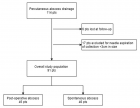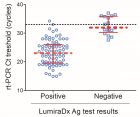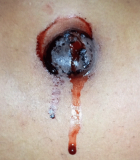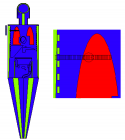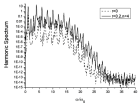Abstract
Research Article
Profiling children with cerebral visual impairment in a tertiary eye care center
Addisu Worku Teshome* and Martha Degefu Worku
Published: 07 April, 2022 | Volume 6 - Issue 1 | Pages: 007-012
Background: Cerebral visual impairment (CVI) is a bilateral visual impairment that affects children in all industrialized countries. It has become more common in low-income countries as a result of the increased survival rates of children who suffer from severe neurological conditions during the perinatal period. The purpose of this study was to determine the characteristics of children with CVI in a tertiary children’s eye care center population.
Methods: From October 2020 to September 2021, a cross-sectional study was conducted to select all consecutive patients with a diagnosis of cerebral visual impairment aged 6 months to 16 years. On the neurological deficit, information was gathered from the patient’s referral: parental interviews, observations, and direct assessment were used for functional vision characteristics, and an ophthalmic examination was performed for eye findings. The interviewees’ responses were matched to the ten specific behavioral characteristics shared by children with CVI. Cortical visual impairment was diagnosed using three criteria: [the vision loss is not explained by abnormalities found on the eye examination, a neurological medical diagnosis, and the child exhibits one of the unique visual and behavioral characteristics described by Roman Lantz]. A descriptive statistical analysis (frequency, mean, and range) was calculated.
Results: Forty children with CVI (1.96% of total children) were seen. The mean age was 2.56 ( 1.98) years. There were 24 (60%) males. On a referral paper of 28, hypoxic-ischemic encephalopathy was the commonest cause mentioned (70.0%). Seizures were the most frequent neurological deficit at presentation. Ophthalmic and neurologic impairments were found in 42.5% of children with CVI. Based on Roman-Lantzy’s three phases of the CVI Range, 90% of children with CVI at the test time had Phase I or Phase II vision.
Conclusion: According to the findings of this study, visual impairment is critical in the diagnosis of CVI. The prevalence of CVI as a cause of childhood vision impairment is significant. Hypoxic-ischemic encephalopathy is the most common cause of CVI. All children with CVI have serious neurological issues, and the majority have associated ophthalmic abnormalities.
Read Full Article HTML DOI: 10.29328/journal.ijceo.1001043 Cite this Article Read Full Article PDF
Keywords:
Profile; Children; Cerebral visual impairment
References
- McClelland J, Saunders KJ, Hill N, Magee A, Shannon M, et al. The changing visual profile of children attending a regional specialist school for the visually impaired in Northern Ireland. Ophthalmic Physiol Opt. 2007; 27: 556–560. PubMed: https://pubmed.ncbi.nlm.nih.gov/17956360/
- Rudanko SL, Fellman V, Laatikainen L. Visual impairment in children born prematurely from 1972 through 1989. Ophthalmology. 2003; 110: 1639–1945. PubMed: https://pubmed.ncbi.nlm.nih.gov/12917186/
- Leuck AH, Dutton GN Vision and Brain. 1st ed. USA: AFB Press; 2015.
- Flanagan NM, Jackson AJ, Hill AE. Visual impairment in childhood: Insights from a community-based survey. Child Care Health Dev. 2003; 29: 493–499. PubMed: https://pubmed.ncbi.nlm.nih.gov/14616907/
- Williams C, Pease A, Warnes P, Harrison S, Pilon F, et al. Cerebral visual impairment-related vision problems I primary school children: a cross-sectional survey. Dev Med Child Neurol. 63: 683-689. PubMed: https://pubmed.ncbi.nlm.nih.gov/33533021/
- Rogers M. Vision impairment in Liverpool: Prevalence and morbidity. Arch Dis Child. 1996; 74: 299–303. PubMed: https://pubmed.ncbi.nlm.nih.gov/8669928/
- Blohmé J, Tornqvist K. Visual impairment in Swedish children. III Diagnoses. Acta Ophthalmol Scand. 1997; 75: 681–687. PubMed: https://pubmed.ncbi.nlm.nih.gov/9527331/
- Good WV, Jan JE, deSa L, Barkovich AJ, Groenveld M, et al. Cortical visual impairment in children: a major review. Surv Ophthalmol. 1994; 38: 351-346. PubMed: https://pubmed.ncbi.nlm.nih.gov/8160108/
- Gilbert CE, Anderton L, Dandona L, Foster A. Prevalence of visual impairment in children: a review of available data. Ophthalmic Epidemol. 1999; 6: 73-82. PubMed: https://pubmed.ncbi.nlm.nih.gov/10384686/
- Williams C, Northstone K, Sabates R, Feinstein L, Emond A, et al. Visual perceptual difficulties and under‐achievement at school in a large community‐based sample of children. PLoS One. 2011; 6: e14772. PubMed: https://pubmed.ncbi.nlm.nih.gov/21445286/
- Macintyre‐Béon C, Young D, Dutton G, Mitchell K, Simpson J, et al. Cerebral visual dysfunction in prematurely born children attending mainstream school. Doc Ophthalmol. 2013; 127: 89-102. PubMed: https://pubmed.ncbi.nlm.nih.gov/23996515/
- Chong CF, Dai S. Cross sectional study on childhood cerebral visual impairment in New Zealand. J AAPOS. 2014; 18: 71-74. PubMed: https://pubmed.ncbi.nlm.nih.gov/24568987/
- van Genderen M, Dekker M, Pilon F, Bals I. Diagnosing Cerebral Visual Impairment in Children with Good Visual Acuity. Strabismus. 2012; 20: 78–83. PubMed: https://pubmed.ncbi.nlm.nih.gov/22612357/
- Saunders KJ, McClelland JF, Richardson PM, Stevenson M. Clinical judgement of near pupil responses provides a useful indicator of focusing ability in children with cerebral palsy. Dev Med Child Neurol. 2008; 50: 33–37. PubMed: https://pubmed.ncbi.nlm.nih.gov/18173628/
- Saunders KJ, Little JA, McClelland JF, Jackson AJ. Profile of refractive errors in cerebral palsy: Impact of severity of motor impairment (GMFCS) and CP subtype on refractive outcome. Invest Ophthalmol Vis Sci. 2010; 51: 2885–2890. PubMed: https://pubmed.ncbi.nlm.nih.gov/20107180/
- https://pcvis.vision/what-is-cvi/
- Roman-Lantzy CA. Cortical visual impairment: Advanced Principles. AFB Press. 2018.
- Dutton GN. Dorsal stream dysfunction and dorsal stream dysfunction plus: A potential classification for perceptual visual impairment in the context of cerebral visual impairment? Dev Med Child Neurol. 2009; 51: 170-172. PubMed: https://pubmed.ncbi.nlm.nih.gov/19260930/
- Huo R, Burden SK, Hoyt CS, Good WV. Chronic cortical visual impairment in children: aetiology, prognosis, and associated neurological deficits. Br J Ophthalmol. 1999; 83: 670-675. PubMed: https://pubmed.ncbi.nlm.nih.gov/10340973/
- Wong VC. Cortical blindness in children: A study of etiology and prognosis. Pdiatr Neurol. 1991; 7: 178-185. PubMed: https://pubmed.ncbi.nlm.nih.gov/1878097/
- Pawar N, Ravindran M, Ramakrishnan R, Maheshwari D. Pediatric cortical visual impairment: Ethiology, associated findings, and prognosis in a tertiary eye care setting in South India. Jclin Ophthalmolo Res. 2018; 6: 53-58.
Figures:
Similar Articles
-
Prospective Clinical Study to Find out Epidemiology of Xerophthalmia in Children in a Tertiary Care Centre in IndiaDeepak Mishra*,Megha Gulati,Prashant Bhushan,Nilesh Mohan,Bibhuti Sinha P. Prospective Clinical Study to Find out Epidemiology of Xerophthalmia in Children in a Tertiary Care Centre in India . . 2017 doi: 10.29328/journal.ijceo.1001010; 1: 066-070
-
The management of Irvine-Gass Syndrome in a patient using Inhaler SteroidAyse Gul Kocak Altintas*,Cagri Ilhan,Mehmet Citirik. The management of Irvine-Gass Syndrome in a patient using Inhaler Steroid . . 2018 doi: 10.29328/journal.ijceo.1001011; 2: 001-005
-
Ocular changes and disorders associated with ObesityBurak Turgut*. Ocular changes and disorders associated with Obesity. . 2018 doi: 10.29328/journal.ijceo.1001015; 2: 018-020
-
Alternative treatment methods in eyes with pseudophakic cystoid macular edemaAyse Gul Kocak Altintas*. Alternative treatment methods in eyes with pseudophakic cystoid macular edema . . 2019 doi: 10.29328/journal.ijceo.1001019; 3: 001-007
-
Retinopathy of prematurity - Intersibling divergence of risk factors among twinsSudeep Navule Siddappa*,Kavitha Chikknayakanahalli Venugopal,Pavana Acharya ,Tintu Susan Joy . Retinopathy of prematurity - Intersibling divergence of risk factors among twins. . 2020 doi: 10.29328/journal.ijceo.1001026; 4: 009-011
-
The evaluation of bandage soft contact lenses as a primary treatment for traumatic corneal abrasionsHashim Thiab Hassan*. The evaluation of bandage soft contact lenses as a primary treatment for traumatic corneal abrasions. . 2020 doi: 10.29328/journal.ijceo.1001032; 4: 041-048.
-
Donor profile and trends of eye donation in Central IndiaNeha Singh Jat*. Donor profile and trends of eye donation in Central India. . 2021 doi: 10.29328/journal.ijceo.1001035; 5: 005-008
-
Profiling children with cerebral visual impairment in a tertiary eye care centerAddisu Worku Teshome*,Martha Degefu Worku. Profiling children with cerebral visual impairment in a tertiary eye care center. . 2022 doi: 10.29328/journal.ijceo.1001043; 6: 007-012
-
Step VEP visual acuity in a pediatric neuro-ophthalmological cohortAlison M Mackay*. Step VEP visual acuity in a pediatric neuro-ophthalmological cohort. . 2022 doi: 10.29328/journal.ijceo.1001046; 6: 026-030
-
VEP visual acuity in children with cortical visual impairmentAlison M Mackay*. VEP visual acuity in children with cortical visual impairment. . 2022 doi: 10.29328/journal.ijceo.1001047; 6: 031-034
Recently Viewed
-
Leiomyosarcoma in pregnancy: Incidental finding during routine caesarean sectionToon Wen Tang*,Phoon Wai Leng Jessie. Leiomyosarcoma in pregnancy: Incidental finding during routine caesarean section. Clin J Obstet Gynecol. 2021: doi: 10.29328/journal.cjog.1001094; 4: 092-095
-
Adult Neurogenesis: A Review of Current Perspectives and Implications for Neuroscience ResearchAlex, Gideon S*,Olanrewaju Oluwaseun Oke,Joy Wilberforce Ekokojde,Tolulope Judah Gbayisomore,Martina C. Anene-Ogbe,Farounbi Glory,Joshua Ayodele Yusuf. Adult Neurogenesis: A Review of Current Perspectives and Implications for Neuroscience Research. J Neurosci Neurol Disord. 2024: doi: 10.29328/journal.jnnd.1001102; 8: 106-114
-
Late discover of a traumatic cardiac injury: Case reportBenlafqih C,Bouhdadi H*,Bakkali A,Rhissassi J,Sayah R,Laaroussi M. Late discover of a traumatic cardiac injury: Case report. J Cardiol Cardiovasc Med. 2019: doi: 10.29328/journal.jccm.1001048; 4: 100-102
-
A two-phase sonographic study among women with infertility who first had normal sonographic findingsKalu Ochie*,Abraham John C. A two-phase sonographic study among women with infertility who first had normal sonographic findings. Clin J Obstet Gynecol. 2022: doi: 10.29328/journal.cjog.1001117; 5: 101-103
-
Sinonasal Myxoma Extending into the Orbit in a 4-Year Old: A Case PresentationJulian A Purrinos*, Ramzi Younis. Sinonasal Myxoma Extending into the Orbit in a 4-Year Old: A Case Presentation. Arch Case Rep. 2024: doi: 10.29328/journal.acr.1001099; 8: 075-077
Most Viewed
-
Evaluation of Biostimulants Based on Recovered Protein Hydrolysates from Animal By-products as Plant Growth EnhancersH Pérez-Aguilar*, M Lacruz-Asaro, F Arán-Ais. Evaluation of Biostimulants Based on Recovered Protein Hydrolysates from Animal By-products as Plant Growth Enhancers. J Plant Sci Phytopathol. 2023 doi: 10.29328/journal.jpsp.1001104; 7: 042-047
-
Sinonasal Myxoma Extending into the Orbit in a 4-Year Old: A Case PresentationJulian A Purrinos*, Ramzi Younis. Sinonasal Myxoma Extending into the Orbit in a 4-Year Old: A Case Presentation. Arch Case Rep. 2024 doi: 10.29328/journal.acr.1001099; 8: 075-077
-
Feasibility study of magnetic sensing for detecting single-neuron action potentialsDenis Tonini,Kai Wu,Renata Saha,Jian-Ping Wang*. Feasibility study of magnetic sensing for detecting single-neuron action potentials. Ann Biomed Sci Eng. 2022 doi: 10.29328/journal.abse.1001018; 6: 019-029
-
Pediatric Dysgerminoma: Unveiling a Rare Ovarian TumorFaten Limaiem*, Khalil Saffar, Ahmed Halouani. Pediatric Dysgerminoma: Unveiling a Rare Ovarian Tumor. Arch Case Rep. 2024 doi: 10.29328/journal.acr.1001087; 8: 010-013
-
Physical activity can change the physiological and psychological circumstances during COVID-19 pandemic: A narrative reviewKhashayar Maroufi*. Physical activity can change the physiological and psychological circumstances during COVID-19 pandemic: A narrative review. J Sports Med Ther. 2021 doi: 10.29328/journal.jsmt.1001051; 6: 001-007

HSPI: We're glad you're here. Please click "create a new Query" if you are a new visitor to our website and need further information from us.
If you are already a member of our network and need to keep track of any developments regarding a question you have already submitted, click "take me to my Query."







